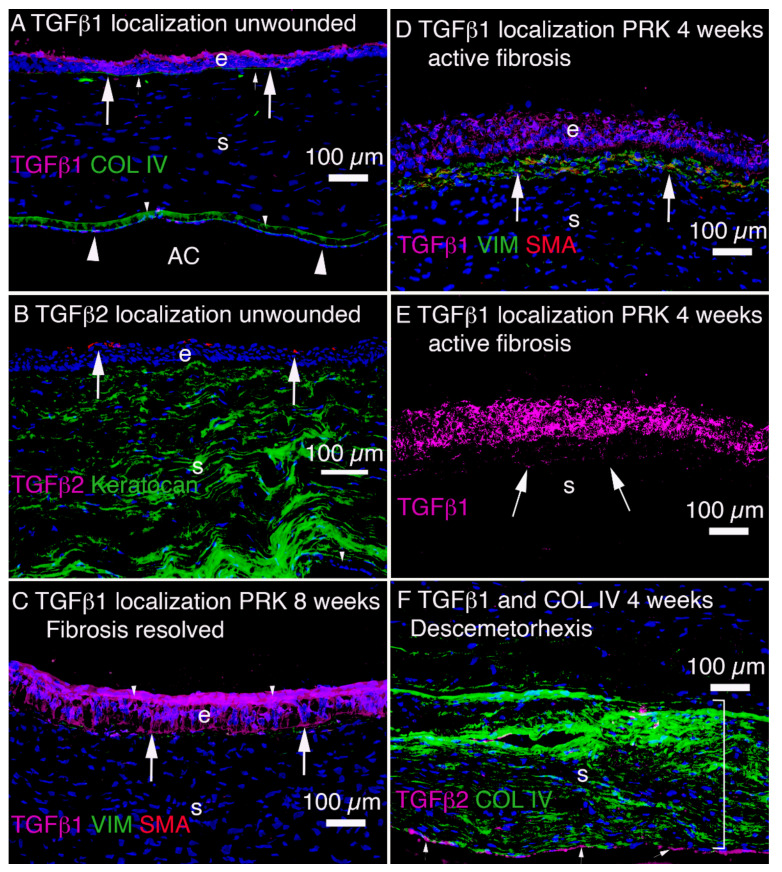Figure 5.
Localization of TGF beta-1 and TGF beta-2 in unwounded and wounded rabbit corneas. (A) TGF beta-1 (TGFb1) is produced (large arrows) in corneal epithelium (e) and endothelium (large arrowheads) and is also present in tears and aqueous humor in the anterior chamber (AC) [5]. In unwounded cornea, collagen type IV (COL IV) is detected in the EBM (small arrows) and in DBM (small arrowheads). (B) TGFb2 is not expressed in the corneal epithelium or corneal endothelium (arrowhead indicates a small area of visible corneal endothelium) but is present in tears (produced by accessory and main lacrimal glands) and in the aqueous humor. (C) In corneas that do not develop fibrosis or in corneas that develop fibrosis that subsequently resolves, as in this cornea at 8 weeks after PRK, TGFb1 is retained from entering the stroma by the fully regenerated EBM (arrows) and regeneration of the superficial epithelial barrier function (EBF, small arrowheads). Note no SMA-positive myofibroblasts remain, but a few vimentin-positive, SMA-negative corneal fibroblasts persist just posterior to the EBM. (D) In a cornea that develops fibrosis 4 weeks after PRK, high levels of TGFb1 (and TGFb2 not shown) accumulate throughout the epithelium (e) and into the anterior stroma (s) without evidence of EBM regeneration or EBF. Numerous SMA-positive myofibroblasts (arrows) and SMA-negative, vimentin-positive corneal fibroblasts are present in the sub-epithelial stroma. (E) The same section as in D, but showing only TGFb1, highlights the penetration of the TGFb1 into the anterior stroma (arrows), although some stromal cells also produce limited amounts of TGFb1 [5]. (F) In a rabbit cornea at 4 weeks after Descemetorhexis removal of an 8 mm disc of DBM and corneal endothelium, TGFb1 (arrows) is localized at the posterior corneal surface still devoid of DBM or endothelium. Much of the posterior stroma (bracket) contains collagen type IV (COL IV) not associated with DBM that is upregulated in corneal fibroblasts by TGFb1. Since COL IV directly binds TGFb1 in competition with cognate TGF beta receptors, it is hypothesized this COL IV is produced to downregulate TGFb1 effects on cells in the posterior stroma, including myofibroblast precursors [7]. A similar upregulation of non-EBM COL IV occurs in the anterior stroma after injuries such as PRK. Panels A and B are previously unpublished images from study de Oliveira et al. Exp Eye Res, 2021;202:108325. Panels C, D and E reprinted with permission from de Oliveira et al. Exp Eye Res, 2021;202:108325. Panel F reprinted with permission from Sampaio LP et al. Exp Eye Res. 2021;213:108803.

